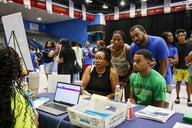You have /5 articles left.
Sign up for a free account or log in.
A recent article on TechCrunch, a leading provider of technology news, argues that for all the hype, higher ed, as we have known it, is prevailing over the forces for disruption. “After years of efforts,” the author writes, “we have arrived in 2015 and almost nothing seems to have changed about the way we get our degrees or even just our continuing coursework.”
As one piece of evidence, the article suggests that enrollment in MOOCs has apparently plateaued. It might also point to the declining enrollment at for-profit universities. Nevertheless, we are, in fact, in the midst of a profound period of transition as public and private universities seek to address a series of challenges. These include:
- The demographic challenge
The new undergraduate student majority consists of non-traditional students: older students, part-time students, commuter students, transfer students, full-time workers, and family caregivers – precisely the kinds of students which higher education has historically served poorly. At a minimum, these students need new scheduling models and support services. - The completion challenge
Only about half of all undergraduates ever receive a bachelor’s degree, an outcome that is unsustainable politically or morally. Current initiatives, such as mandatory orientations and advising sessions, incentivizing a 15 hour load, and instituting accelerated courses during the summer or semester breaks, have moved the needle modestly. More dramatic gains will require more radical approaches. - The financial challenge
As more and more students complete their general education requirements in high school or at a community college, many four-year institutions are losing the cross-subsidies through which large lower-division lecture classes pay for small upper-division courses. Meanwhile, many institutions face additional financial challenges, including the ever rising costs of student recruitment, financial aid, instructional technology, support services, and assessment, accreditation, and compliance, while many families feel overwhelmed by the cost of tuition, fees, and books.
Then there is the biggest challenge of all: From those students who expect an education that differs dramatically from what higher ed has traditionally provided. Many seek an education that is more career-focused or more experiential or more flexible than what higher education has traditionally offered.
The most obvious development involves the embrace of flipped classrooms, of online education, and, at a growing number of institutions, open education resources -- developments that are reshaping the student experience even at residential campuses.
Research is becoming a more integral part of the undergraduate experience. So, too, is study abroad and for-credit internships. Ditto for learning analytics, which can identify at-risk students and curriculum bottlenecks, and measure the effectiveness of support services.
Then there are new kinds of joint degrees, like Stanford’s CS+X initiative, which integrates computer science with a humanities discipline. Especially noteworthy are the growing number of academic incubators and accelerators. These provide a physical space where faculty, students, and industry can forge strategic partnerships and work collaboratively on projects with commercial potential.
Yet I would suggest that the some of the most striking innovations will achieve prominence in the next few years.
1. Curricular Redesign
Many departments are launching efforts to make their curricula more coherent, with clearly identified, measurable learning objectives and an intentionally designed progression of courses.
2. Bridge to Work Programs
Modeled on the co-op programs at Drexel and Northeastern, such programs make internships an integral part of the student experience.
3. Instructional Resource Repositories
A growing number of institutions are curating a wide range of instructional assets – animations, interactives, simulations, virtual laboratories, and assessments – and making them available to faculty.
4. Treating Teaching as a Research Activity
By analyzing data drawn from a range of data silos, campuses are able to better understand student learning, customize learning pathways, and evaluate the effectiveness of various pedagogical approaches and institutional interventions.
Steven Mintz is Executive Director of the University of Texas System's Institute for Transformational Learning and Professor of History at the University of Texas at Austin. Harvard University Press just published his latest book, The Prime of Life: A History of Modern Adulthood.



